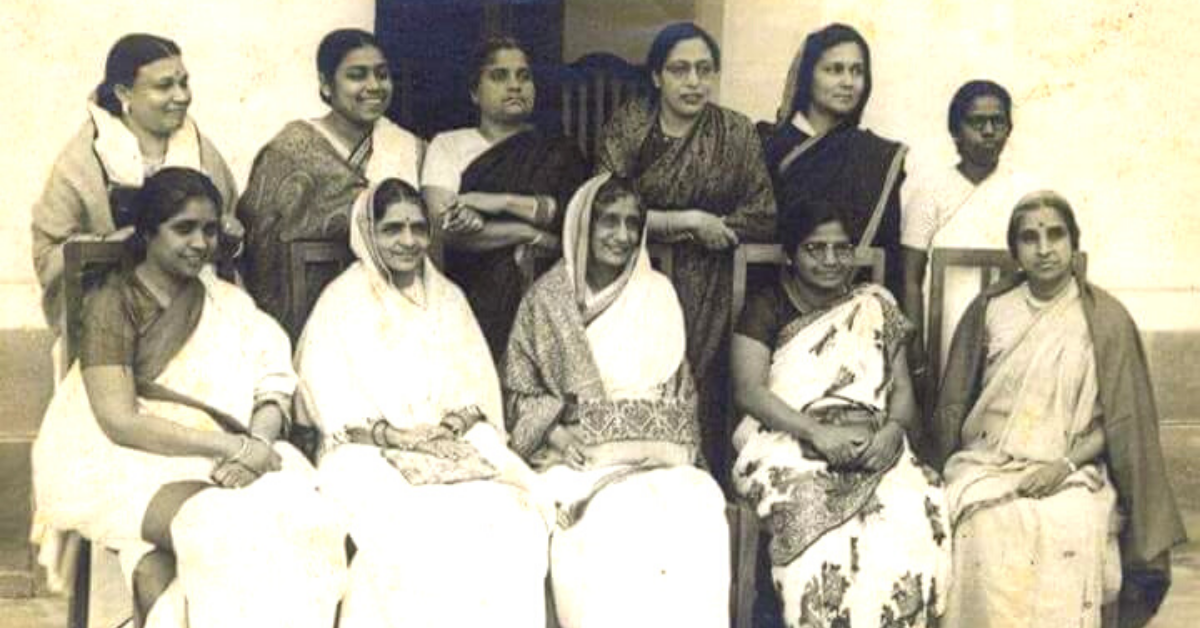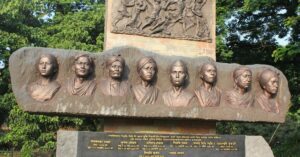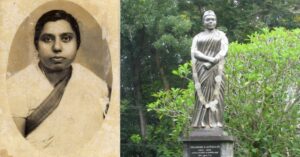Republic Day: 15 Fierce Women Who Helped Create the Indian Constitution
“The working of the Constitution will depend upon how the people will conduct themselves in the future, not on the actual execution of the law. So, I hope that in the course of time there will not be such a community known as Untouchables.”

The Indian Constitution, which was adopted by the elected Constituent Assembly on 26 November 1949, is the longest in the world. Subsequently, it was legally enforced on 26 January 1950, the day that is today celebrated as Republic Day.
Among the 299 members of the Constituent Assembly, were 15 women—who were either voted in or chosen to represent their province.
Each one of them broke the glass ceiling way before it even became a ‘thing.’ From fighting child marriage to working relentlessly to uplift those who were in weaker economic, financial, and social positions—these freedom fighters, lawyers, reformists, and politicians did extraordinary work and as a part of the assembly, helped craft a politically balanced republic.
This Republic Day, let’s take a look at the lives of these 15 women.
1. Dakshayani Velayudhan

At 34, Dakshayani was the youngest member of the assembly. Hailing from the Pulaya community of Cochin she was among the first generation of women of her community to be educated and was nominated to the to the Cochin Legislative Council in 1945.
An unwavering supporter of a common national identity for every Indian, Dakshayani did not support separate electorates or reservation. Also, despite being a staunch follower of both Gandhi and Dr BR Ambedkar, she never shied away from challenging them both on the strength of her own convictions.
Ten days after the assembly met for the first time, Dakshayani stood before it and delivered her first impassioned speech slamming untouchability, where she stated, “The working of the Constitution will depend upon how the people will conduct themselves in the future, not on the actual execution of the law. So, I hope that in the course of time there will not be such a community known as Untouchables.”
Read more about the incredible work she did here.
2. Ammu Swaminathan

A fiery feminist from her early years, Ammu, when told that she would have to wed at the age of 13, presented her own set of conditions before agreeing. These included moving to Madras and getting an English education.
It was in 1914 that she became an active participant in politics and three years later in 1917, formed the Women’s India Association along with other stalwarts like Annie Besant, Margaret Cousins, Malathi Patwardhan, Mrs Dadabhoy and Mrs Ambujammal.
In 1934 she joined the Indian National Congress and went on to be elected from the Madras Constituency. A firm advocate for the abolishment of the archaic and oppressive caste system Ammu sided with Dr BR Ambedkar for several caste-related issues.
In a speech during the discussion on the motion by Dr B R Ambedkar to pass the draft Constitution on 24 November 1949, an optimistic and confident Ammu said, “People outside have been saying that India did not give equal rights to her women. Now we can say that when the Indian people themselves framed their Constitution, they have given rights to women equal with every other citizen of the country.”
3. Hansa Jivraj Mehta

Article 1 of the Universal Declaration of Human Rights (UDHR), stated, “All men are born free and equal.” It was subsequently amended to read, “All human beings are born free and equal.”
While the change was small, the impact of it was undoubtedly very far-reaching, and the credit for this rests entirely on Hansa Jivraj Mehta’s shoulders.
Born into affluence on 3 July 1897, Hansa’s father Manubhai Nandshankar Mehta was the then Dewan of Baroda. She went to England as a young child and studied Sociology and Journalism before returning to India.
Hansa was actively involved in the Non-Cooperation and Swadeshi movements. She went on to contest and won the first provincial elections from the Bombay Legislative Council seat in 1937 and served two terms on the council (1937-39 and 1840-49) and would subsequently join the Constituent Assembly.
Just before joining the Constituent Assembly, she was also instrumental in drafting the Indian Women’s Charter of Rights and Duties during the 1946 (and 18th) session of the AIWC in Hyderabad.
On 15 August 1947, Hansa presented the newly-independent nation’s first national flag on behalf of its women, stating, “We have donned the saffron colour, we have fought, suffered and sacrificed in the cause of our country’s freedom. We have today attained our goal. In presenting this symbol of our freedom, we once more offer our services to the nation.”
4. Leela Roy

Born in Goalpara in Assam in October 1900, Leela was the first woman to obtain an MA from the University of Dhaka in 1923. In the same year, she also established ‘Dipali Sangha’, an association for women that encouraged and taught social and political awareness to women.
An ardent supporter of education, she set up the second school for women in Dhaka and laid a firm emphasis on martial arts and vocational training. Also a prolific writer, in 1931, she began publishing Jayasree, the first magazine edited, managed, and wholly contributed by women writers.
Leela was sworn in as a member of the Constituent Assembly from Bengal on 9 December 1946 and was the only woman member from Bengal to be elected. However, she tendered her resignation a few months later as a mark of protest against the partition of India.
5. Durgabai Deshmukh

Durgabai was all of 12 when she first participated in the Non-Cooperation movement. Deeply influenced by Mahatma Gandhi, she immersed herself completely in the freedom struggle.
In 1936, she established the Andhra Mahila Sabha, which within a decade became a great institution of education and social welfare in the city of Madras.
“I had then decided to take up the study of law so that I could give such women free legal aid and assist them to defend themselves,” she wrote in her autobiography following her incarceration, when she shifted focus from politics to her education.
Durgabai studied law, and in 1942, at the height of the Quit India Movement, she was accepted into the Madras Bar.
She was inducted into the constituent assembly in 1946 where she actively participated the debates, fiercely defending property rights for women under the Hindu Code Bill, independence of the judiciary, selection of Hindustani (Hindi+Urdu) as the national language and for lowering the age bar for those seeking to hold seats in the subsequent council of states from 35 to 30.
You can read more about her here.
6. Begum Aizaz Rasul

The only Muslim woman member in the Constituent Assembly, Aizaz Rasul formally gave up the purdah in 1937 when she won her first election from the non-reserved seat and became a member of the Uttar Pradesh Legislative Council.
Hailing from a political family, Rasul’s induction into politics started rather early on in life. She would accompany her father, Zulfiqar Ali Khan, to various meetings and sometimes even took notes as his secretary.
Her monumental contributions to the Constituent Assembly debates have been recorded in many official sources. She went on to serve the Indian National Congress from 1952 to 1958 as a member of the Rajya Sabha. Besides her political commitments, she also served as the President of the Indian Women Hockey Federation for over fifteen years. She was eventually selected as the President of the Asian Women’s Hockey Federation.
She was known to be a very articulate woman who never shied away from making her point. For example, while criticising the limitations set on fundamental rights in the framing of the Constitution, she said, “I find that what has been given with one hand has been taken away by the other.”
7. Kamla Chaudhary
Known to be among the most active women members during the Civil Disobedience Movement in 1930, Kamla was jailed several times during that period.
In 1946, she was made the Vice President at the 54th conference of the Congress held in Meerut and subsequently went on to become a member of the Constituent Assembly from 1947 to 1952.
Kamla was also a prolific writer and wrote extensively on gender discrimination, exploitation of peasants, and poor condition of widows in the society.
8. Sucheta Kriplani

A freedom fighter, a member of the Constituent Assembly, a Chief Minister and a path-breaker for women everywhere – Sucheta Kriplani played a very vital role during India’s freedom struggle. She was also responsible for establishing the Women Wing in the INC in 1940. She also went on to assist Gandhi during the Satyagraha movement as well.
One of the proudest moments for her in her political career came when she was invited to sing renditions of Vande Mataram, Saare Jahan Se Acha and Jana Gana Mana just before India’s first Prime Minister Jawaharlal Nehru delivered his famous “Tryst with Destiny” speech.
You can read more about her life here.
9. Malati Choudhury
It was Mahatma Gandhi who gave Malati the nickname – toofani. A Constituent Assembly member from Odisha, Malati put in immense efforts towards the upliftment of the scheduled caste, scheduled tribes, and other backward classes in society.
At the age of 16, she reached Shantiniketan, where she studied at VisvaBharati University. She went on to marry Nabakrushna Choudhuri, who later became the Chief Minister of Odisha and shifted to Odisha in 1927.
She and her husband played a pivotal role during the Satyagraha movement, where they mobilised people to participate in the movement. They educated and communicated with the people to create a favourable environment for Satyagraha. She is also credited with having set up several organisations such as the Bajiraut Chhatravas for the upliftment of vulnerable communities in Odisha.
10. Purnima Banerjee
As the secretary of the Indian National Congress committee in Allahabad, Uttar Pradesh, Purnima was one among a radical network of women from Uttar Pradesh who stood at the forefront of the freedom movement in the late 1930s and 1940s. One of the things that she is often remembered for is the passionate and fiery speech that she delivered in the Constituent Assembly, displaying her commitment to a socialist ideology.
Jailed during the Satyagraha and Quit India movement protests, reports suggest that she went on to complete her Bachelor of Arts from jail. She is counted amongst the fearless women who were willing and ready to take on the British.
11. Sarojini Naidu

Source
Sarojini Naidu, who is also known as the “Nightingale of India,” holds the distinction of being the first Indian woman to be president of the Indian National Congress in the year 1925. She was also appointed as an Indian State Governor.
Having studied at King’s College in London and later on at Cambridge, she was drawn to Mahatma Gandhi’s Non-Cooperation Movement. In 1924 she travelled across Africa where she spent time understanding the interests of Indians there.
Her anti-British activity led her to face many jail terms. In 1914 she was elected to be a fellow of the Royal Society of Literature. In 1917 Sarojini Naidu led a delegation of women to meet the Montagu-Chelmsford Committee to demand a series of reforms in the condition of Indian women.
12. Rajkumari Amrit Kaur

Source: History To Know
As the co-founder of the All India Women’s Conference in 1927, Rajkumari Amrit was known to be a humanitarian who worked tirelessly for the upliftment of the downtrodden.
She set up the Tuberculosis Association of India, the Central Leprosy and Research Institute, and was also the Vice-Chair of the board of governors of the League of Red Cross Societies and chair of the executive committee of St John’s Ambulance Society.
She also worked towards abolishing child marriage and the purdah system.
Rajkumari Amrit was also the first woman cabinet minister of free India. According to this report, She introduced the AIIMS Bill, 1956 (which set up AIIMS, Delhi) in both the houses and was instrumental in the passing of the Bill as an Act.
13. Annie Mascarene
Annie represented the Princely State of Travancore and Cochin Union in the Constituent Assembly. During the debates in the assembly, she spoke very passionately about federalism. She went on to be elected as an independent candidate to the first Lok Sabha as well. In doing so, she became the first woman from Kerala to find a spot in the Lok Sabha.
14. Vijaylakshmi Pandit

There is more to Vijayalakshmi Pandit than just being known as the sister of Jawaharlal Nehru. A feisty freedom fighter in her own right, she had been imprisoned on several occasions, including while participating in the Quit India Movement. She was India’s first-ever woman Cabinet Minister and the first Asian president of the United Nations General Assembly
15. Renuka Ray
Renuka Ray was another of those who had chosen a life of service towards India’s independence and development, rather than live in the comfort she was born into.
As the daughter of an ICS officer and a social worker, Renuka Ray had completed her BA from the London School of Economics, before returning to India and joining the All India Women Congress.
She was instrumental in ensuring that the Constitution recognised the equality of women. She had an active political career From 1943 to 1946 she was a member of the Central Legislative Assembly, then of the Constituent Assembly and the Provisional Parliament, and from1952–57, she served on the West Bengal Legislative Assembly as Minister for Relief and Rehabilitation.
In 1957 and again in 1962, she was the member for Malda of the Lok Sabha.
While we celebrate and applaud women who break the glass ceiling today, we must also look back at history and learn about how the women then started it all.
Also Read: This Warm 78-Year-Old ‘Campus Nani’ Teaches You How to Pick Yourself up and March On
(Edited by Gayatri Mishra)
Like this story? Or have something to share?
Write to us: [email protected]
Connect with us on Facebook and Twitter.
This story made me
- 97
- 121
- 89
- 167
Tell Us More
We bring stories straight from the heart of India, to inspire millions and create a wave of impact. Our positive movement is growing bigger everyday, and we would love for you to join it.
Please contribute whatever you can, every little penny helps our team in bringing you more stories that support dreams and spread hope.



















